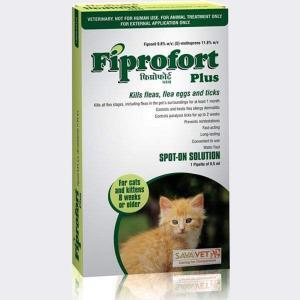Table of Contents
Fipronil + Methoprene is a combination of active ingredients commonly found in certain methoprene flea control products for cats and kittens.

What Is Fiprofort Plus for Cats and Kittens?
Fipronil is an insecticide that targets fleas and ticks’ nervous system. It kills adult fleas and ticks on contact, effectively controlling infestations. Fipronil is known for its long-lasting effects and is commonly used in topical spot-on treatments.
What is Methoprene used for? Methoprene is an insect growth regulator (IGR) often combined with Fipronil in flea control products. The methoprene mode of action involves inhibiting the development of flea eggs and larvae, thereby breaking the life cycle of fleas. In addition, Methoprene helps to prevent re-infestation by controlling the growth and reproduction of fleas.
The combination of Fipronil and Methoprene provides a comprehensive approach to flea control, targeting both adult fleas and the immature flea life cycle stages. This combination is often found in flea control products that provide long-lasting protection against fleas and their eggs.
Ingredients
The medicine contains
- Fipronil 9.8% w/w
- (S)-Methoprene 11.8% w/w
- Excipients q.s.
Forms of the Medicine
The combination of Fipronil and Methoprene is commonly available in topical spot-on formulations for cats. These spot-on treatments are applied directly to the skin, usually between the shoulder blades, and provide localized protection against fleas and ticks.
Spray
There are available sprays that contain Fipronil and/or Methoprene as active ingredients. In addition, sprays for flea control often contain other active ingredients.
Granules
Fipronil and Methoprene granules are usually used for outdoor pest control in yards and gardens.
Oral medication
Fipronil and Methoprene are not typically combined in oral medications for cats. Therefore, oral medications for flea control in cats usually contain other active ingredients.
Formulations and product availability can vary over time and by region. For accurate and up-to-date information about specific products containing Fipronil and Methoprene, consult a veterinarian or check with the manufacturer or distributor of the product you are interested in. They can provide detailed information about the available forms and their appropriate usage for your cat.
Uses of Fipronil and Methoprene
It is typically used to control and prevent flea and tick infestations in cats and kittens. Fiprofort Plus, which contains Fipronil as one of the active ingredients, is applied topically between the shoulder blades of cats to protect against fleas and ticks.
Fipronil is effective in killing adult fleas and ticks on contact, and it also helps to control flea eggs and larvae, breaking the flea life cycle. This can help reduce the risk of re-infestation in cats and their environment.
Who Can Use the Medicine?
Specific products may have different instructions and usage guidelines based on the brand and formulation. Therefore, always read and follow the instructions provided by the specific product you are using, as dosages and application methods may vary.
Fiprofort Plus for Cats (Fipronil + Methoprene)
Is Methoprene safe for cats?
This product is typically formulated and explicitly labeled for cats, so methoprene safety is proven. It is commonly used to control and prevent flea and tick infestations in cats and kittens. The combination of Fipronil and Methoprene in Fiprofort Plus helps to kill adult fleas and ticks on contact. In addition, it inhibits the development of flea eggs and larvae, breaking the flea life cycle.

Medication for Dogs (Fipronil + Methoprene)
Fipronil + Methoprene combination products are also available for dogs. Similar to the use in cats, these products control and prevent flea and tick infestations in dogs. They protect against adult fleas and ticks and help break the flea life cycle by controlling the development of flea eggs and larvae.
It’s advisable to consult a veterinarian before using any flea and tick medication to ensure it is appropriate for your pet’s species, age, weight, and overall health.
Dosage Sizes
Recommended Dosage of Fiprofort Plus for Cats & Kittens 8 weeks or older is 0.5ml/ pipette.
Monthly application is recommended for cats. All cats in a household should be treated at the same time. In addition, treating all household cats if any pet is allergic to fleas (flea allergy dermatitis) is crucial.
How to Use Spray
How to apply flea treatment to dogs and cats?
Here are general instructions on how to use Fiprofort Plus for Cats & Kittens that contain Fipronil and Methoprene:
- Read the instructions: Carefully read and follow the instructions provided by the manufacturer on the product label. These instructions will provide specific guidance on the dosage, application method, and any safety precautions.
- Prepare the area: Ensure that the area where you apply the methoprene flea spray is well-ventilated. Consider doing it outdoors or in a well-ventilated room to avoid inhaling the spray.
- Protect yourself: Use protective gloves to avoid direct contact with the spray. Consider also wearing a face mask to prevent inhalation of the spray particles.
- Apply the spray: Hold the spray bottle upright and at a distance as recommended by the product instructions. Start at the neck area and work your way back, spraying the product onto the cat’s coat. Be sure to cover the entire body, focusing on areas where fleas and ticks are commonly found, such as around the neck, under the legs, and around the tail.
- Avoid the eyes, mouth, and ears: Avoid spraying the product directly into your cat’s eyes, mouth, or ears. You can use a cloth or your hand to protect these areas while applying the spray.
- Allow the coat to dry: Allow the coat to air dry naturally, without towel-drying or rinsing off the product, unless instructed otherwise by the product label. This will allow the product to distribute and provide protection effectively.
These instructions are general guidelines, and it’s crucial always to follow the specific instructions provided by the veterinarian.
Important Safety Information for Owners
You must be aware of specific safety considerations when using any medication containing Fipronil + Methoprene for your pet. However, it’s always best to consult a veterinarian for detailed and accurate guidance. Here are some essential safety tips to keep in mind:
- Species-specific use: Ensure the medication is specifically formulated for the species you treat. Products intended for dogs should not be used on cats, and vice versa. Using the wrong product on your pet can lead to adverse effects.
- Age and weight considerations: Consider your pet’s age and weight when determining the appropriate dosage. Some products may have age or weight restrictions, so following the manufacturer’s guidelines is essential.
- Follow dosage instructions: Administer the medication according to the recommended dosage. Do not exceed the prescribed amount, as it can harm your pet.
- Safety for pregnant or nursing animals: If your pet is pregnant, nursing, or has underlying health conditions, consult a veterinarian before using any medication, as it may require special considerations or alternatives.
- Monitor for adverse reactions: Watch for any signs of adverse reactions or sensitivity after application, such as excessive drooling, vomiting, diarrhea, tremors, or skin irritation. If you notice any unusual symptoms, contact your veterinarian immediately.
- Keep children away: Keep children and other pets away from treated animals until the medication has dried. Children should not handle or have direct contact with the medication.
Veterinary Prescription
The requirement for a veterinary prescription to purchase Fiprofort Plus for Cats & Kittens can vary depending on the regulations and guidelines of the country or region where you reside. In some places, certain flea and tick medications containing Fipronil + Methoprene may be available over the counter without a prescription. In contrast, in others, a prescription from a veterinarian may be necessary.
People often ask: Where can I buy cheap Methoprene and Fipronil spray? You can buy it online at discount prices.

Contraindications
Like any other medication, Fiprofort Plus for Cats & Kittens may have contraindications, which are specific conditions or situations in which the medication should not be used. Here are some common contraindications associated with this medication:
- Hypersensitivity or allergy: If your pet has a known hypersensitivity or allergy to Fipronil, Methoprene, or any other ingredients in the medication, it is typically contraindicated. Allergic reactions can include skin irritation, itching, redness, or more severe symptoms.
- Age restrictions: Some products may have age restrictions, meaning they are not suitable for very young animals, such as puppies or kittens under a certain age. Always follow the manufacturer’s age recommendations or consult a veterinarian.
- Underlying health conditions: Pets with certain underlying health conditions, such as liver or kidney disease, may have a higher risk of adverse effects when using this medication.
- Concurrent medications: Certain medications or treatments may interact with Fipronil + Methoprene medication, potentially leading to adverse effects or reduced efficacy. Inform your veterinarian about any medications or treatments your pet receives to ensure no contraindications or interactions.
- Pregnant or nursing animals: In some cases, medication may not be recommended for pregnant or nursing animals. This is due to potential risks to the developing fetuses or the nursing offspring. Always consult with a veterinarian for guidance in these situations.
Side Effects
Fiprofort Plus for Cats & Kittens can cause side effects in pets. While not all animals will experience side effects, being aware of potential adverse reactions is essential. Here are some commonly reported side effects associated with this medication:
- Skin irritation: Some animals may experience mild skin irritation at the application site, including redness, itching, or hair loss. This is typically temporary and resolves on its own.
- Gastrointestinal upset: In some cases, pets may experience gastrointestinal symptoms such as vomiting, diarrhea, or loss of appetite. These symptoms are generally self-limiting and improve without intervention.
- Allergic reactions: Although rare, allergic reactions to Fipronil + Methoprene medication can occur. Signs of an allergic reaction may include swelling of the face, lips, or tongue, difficulty breathing, hives, or collapse. If you observe any of these signs, seek immediate veterinary attention.
- Neurological symptoms: In rare cases, pets may exhibit neurological symptoms such as tremors, instability, or seizures. If any neurological signs are observed, it is crucial to seek immediate veterinary care.
It’s important to note that these side effects are not exhaustive, and individual pets may react differently to medication. Contact your veterinarian if you notice any concerning or persistent side effects.
Overdose
An overdose of Fiprofort Plus for Cats & Kittens can be a serious concern and should be addressed immediately. It’s crucial to seek veterinary assistance if you suspect an overdose or if your pet accidentally ingests or is exposed to excessive medication. Here’s what you should know:
- Signs of overdose: Signs of an overdose can vary depending on the amount ingested, the size of the animal, and individual sensitivity. Common signs may include excessive drooling, vomiting, diarrhea, tremors, unsteady gait, muscle twitching, seizures, and in severe cases, it can lead to life-threatening situations.
- Contact your veterinarian: If you suspect your pet has been exposed to an overdose of Fipronil + Methoprene medication, contact your veterinarian immediately for guidance.
- Emergency veterinary care: In cases of severe overdose or when your pet displays severe symptoms, it’s vital to seek emergency veterinary care. Contact your nearest emergency veterinary clinic or follow the instructions provided by your veterinarian.
- Provide information: When contacting the veterinarian, provide them with accurate information regarding the type of medication, the amount ingested or applied, and any observed symptoms. This will help them assess the situation and provide appropriate advice.
Prevention is always the best approach to avoid an overdose. Follow the recommended dosage guidelines provided by the manufacturer or your veterinarian. Apply the medication only as directed and store it securely outside your pet’s reach.
Fiprofort Poisoning
If you suspect methoprene toxicity in cats or dogs or if it displays symptoms of poisoning after exposure to the medication, it is crucial to take immediate action.
Symptoms of Fiprofort Plus for Cats & Kittens spray poisoning can vary depending on the amount ingested, the size of the animal, and individual sensitivity. However, common signs may include excessive drooling, vomiting, diarrhea, tremors, unsteady gait, muscle twitching, and seizures, and in severe cases, it can lead to life-threatening situations.
Contact your veterinarian immediately or call a pet poison control hotline such as the ASPCA Animal Poison Control Center (APCC) or the Pet Poison Helpline. They have experienced professionals who can guide the following steps to take. First, when contacting the veterinarian or pet poison control hotline, provide them with accurate information about the suspected poisoning, including the type of medication, the amount ingested or applied, and any observed symptoms. This information will help them assess the situation and provide appropriate advice. Then, follow the instructions provided by the veterinarian or pet poison control hotline.
If the situation is severe or if instructed by the veterinarian or poison control hotline, take your pet to the nearest emergency veterinary clinic immediately. They will be able to provide immediate medical attention and treatment to help stabilize your pet.
Storage
Fiprofort Plus for Cats & Kittens spray should be stored in a cool, dry place away from direct sunlight and extreme temperatures. Excessive heat or cold can degrade the effectiveness of the active ingredients. Store the spray in a secure location inaccessible to children and pets. Consider using childproof locks or cabinets to prevent accidental exposure or ingestion. Ensure that the spray container is tightly sealed after each use. This helps maintain the quality and potency of the product over time. Prevent cross-contamination by storing the spray away from food, beverages, and other household items. Avoid storing it near cleaning products or chemicals.
Generic and Brand Names of Fiprofort Plus
Fipronil and Methoprene is an active ingredient combination used in various flea and tick control products. Availability and brand names can vary depending on your location. Here are a few examples of brand names that may offer Fipronil + Methoprene spray formulations:
- Frontline Plus: Frontline Plus is a well-known brand offering a range of flea and tick control products for dogs and cats, including sprays. Some of their products may contain Fipronil + Methoprene.
- PetArmor Plus: PetArmor Plus is another brand that offers flea and tick control products for dogs and cats. They may have a spray formulation that contains Fipronil + Methoprene.
- Sentry Fiproguard Plus: Sentry Fiproguard Plus is a brand that offers flea and ticks control products for dogs and cats. They may have a spray formulation containing Fipronil + Methoprene.
Other Drugs in the Same Class
Fipronil + Methoprene is a combination of two active ingredients used in flea and tick control products. While no exact equivalents or drugs in the same class combine these specific ingredients, other active ingredients are used in similar flea and tick control products. Other active ingredients that are commonly used in flea and tick control products include:
- Imidacloprid;
- Selamectin;
- Permethrin (Methoprene is less toxic than permethrin);
- Pyrethrin;
- Pyrethroids (such as cypermethrin and permethrin);
- Spinosad;
- Nitenpyram.
It’s important to note that the specific formulations and combinations of active ingredients may vary among different brands and products. Always consult a veterinarian or check the product label to determine the active ingredients in a specific flea and tick control product.
Active Ingredients of the Spray Comparing to Other Medications
Fipronil vs Imidacloprid
- Fipronil: Fipronil is an insecticide targeting the nervous system of fleas and ticks. It blocks specific receptors, leading to the disruption of normal nerve function and ultimately causing the death of the parasite. Fipronil is an effective flea treatment, as well as ticks and other external parasites.
- Imidacloprid: Imidacloprid is another insecticide that acts on the nervous system of insects. It targets specific receptors, causing overstimulation and leading to paralysis and death. Imidacloprid is also effective against fleas and some other pests.
Both Fipronil and Imidacloprid are widely used in various flea and tick control products for pets. While they have different chemical structures and action modes, both effectively kill and control fleas and ticks. The choice between Fipronil and Imidacloprid may depend on factors such as the specific product, the species of pet, and any specific considerations or recommendations from your veterinarian.
Methoprene or Pyriproxyfen Products
- Methoprene: Methoprene is an insect growth regulator (IGR) that mimics the effects of a juvenile hormone in insects. It disrupts the normal development of flea eggs and larvae, preventing them from reaching the adult stage and reproducing. Methoprene is commonly used in flea control products to help break the flea life cycle.
- Pyriproxyfen: Pyriproxyfen is another insect growth regulator (IGR) that works similarly to Methoprene. It also interferes with the development of flea eggs and larvae, preventing them from maturing into adults.
Both Methoprene and Pyriproxyfen effectively control flea infestations by targeting the immature stages of fleas. They help to prevent the development of eggs and larvae, reducing the population of fleas and interrupting their life cycle. The choice between Methoprene and Pyriproxyfen may depend on the specific product formulation and any specific recommendations from your veterinarian.
It’s important to note that the effectiveness of any flea and tick control product depends not only on the active ingredients but also on factors such as proper application, dosage, and following the product’s instructions. Therefore, consulting a veterinarian is always recommended to determine the most appropriate flea and tick control product for your pet’s needs.
FAQ
How Does Topical Flea Treatment Work?
Topical flea treatments, such as spot-on treatments, apply a liquid solution directly onto your pet’s skin, typically between the shoulder blades or along the back. The active ingredients in the treatment are absorbed into the skin and distributed throughout the pet’s body via the bloodstream. When fleas come into contact with your pet’s treated skin, they are exposed to the active ingredients, which can kill or repel them. Some topical treatments also target flea eggs and larvae, helping to control the entire flea life cycle.
How Long Does It Take for Flea Treatment to Work?
The time it takes for flea treatment to work can vary depending on the specific product and the severity of the flea infestation. Topical flea treatments generally kill fleas within a few hours to a few days. However, it’s important to note that eliminating fleas can be a gradual process, as the treatment needs to disrupt the entire flea life cycle, which can take several weeks. Therefore, regular and consistent application of the flea treatment according to the instructions is vital for optimal effectiveness.
Is Methoprene Safe for Humans?
Methoprene, an insect growth regulator used in flea control products, is generally considered safe when used according to the instructions on the product label. However, flea control products are specifically formulated for pets and should not be applied to humans as lice treatment containing Fipronil. Direct exposure to concentrated forms of Methoprene, such as refined products, can cause skin irritation or allergic reactions in some individuals. If accidental exposure occurs, washing the affected area thoroughly with soap and water is recommended. If any adverse symptoms persist, it is advisable to seek medical attention.
Is Fipronil and Methoprene Combination Beneficial?
The combination of Fipronil and Methoprene in flea control products can be beneficial for comprehensive flea control. Fipronil targets adult fleas and ticks, while Methoprene works as an insect growth regulator, disrupting the development of flea eggs and larvae. By combining these two active ingredients, the treatment can provide immediate killing action on adult fleas and long-term control by preventing the growth and reproduction of the immature stages. This combination can help break the flea life cycle and provide more effective flea control for pets.
Which Is the Best Flea Treatment for Cats?
The best cat flea treatment can vary depending on factors such as the cat’s age, weight, health condition, and any specific recommendations from your veterinarian. Various effective flea treatment options are available for cats, including topical spot-on treatments like Fiprofort Plus.

































